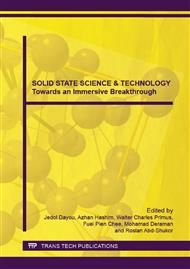[1]
Shin JH, Henderson WA, Passerini S (2005) An Elegant Fix for Polymer Electrolytes, Electrochemical and Solid-State Letters, 8 (2) A125-A127.
DOI: 10.1149/1.1850387
Google Scholar
[2]
Burey P, Bhandari BR, Howes T, Gidley MJ (2008) Hydrocolloid gel particles: formation, characterization, and application. Critical Reviews in Food Science and Nutrition, 48: 361-377.
DOI: 10.1080/10408390701347801
Google Scholar
[3]
Pereira L, van de Velde F (2011) Portuguese carrageenophytes: carrageenan composition and geographic distribution of eight species (Gigartinales, Rhodophyta). Carbohydrate Polymers, 84, 614-623.
DOI: 10.1016/j.carbpol.2010.12.036
Google Scholar
[4]
Wong W Y, Sahidan S, Rohaya M A W, Nazaruddin R, Shahrul H Z A (2012) Cytotoxicity and antibacterial study of carrageenan and seaweed powder 131-136.
Google Scholar
[5]
Sook WC, Hamed M, Farah ST, Tau CL, Chin PT (2013).
Google Scholar
[6]
Dyrby M, Petersen RV, Larsen J, Rudolf B, Norgaard L, Engelsen, SB (2004) Towards on-line monitoring of the composition of commercial carrageenan powders. Carbohydrate Polymers, 57: 337-348.
DOI: 10.1016/j.carbpol.2004.05.015
Google Scholar
[7]
Park SY, Lee BI, Jung ST, Park HJ (2001) Biopolymer composite films based on k-carrageenan and chitosan, Materials Research Bulletin 36: 511–519.
DOI: 10.1016/s0025-5408(01)00545-1
Google Scholar
[8]
Aldalbahi A, Chu J, Feng P, Panhuis, M (2012) Conducting composite materials from the biopolymer kappa-carrageenan and carbon nanotubes. Beilstein Journal of Nanotechnology, 3 : 415-427.
DOI: 10.3762/bjnano.3.48
Google Scholar
[9]
Mobarak NN, Ramli N, Ahmad A, Rahman MYA (2012) Chemical interaction and conductivity of carboxymethyl κ-carrageenan based green polymer electrolyte. Solid State Ionics 224: 51–57.
DOI: 10.1016/j.ssi.2012.07.010
Google Scholar
[10]
Fan L, Wang L, Gao S, Wu P, Li M, Xie W, Liu S, Wang W (2011) Synthesis, characterization and properties of carboxymethyl kappa carrageenan. Carbohydrate Polymers 86: 1167– 1174.
DOI: 10.1016/j.carbpol.2011.06.010
Google Scholar
[11]
Fujishima M, Matsuo Y, Takatori H, Uchida K, (2008) Proton-conductive acid–base complex consisting of κ-carrageenan and 2-mercaptoimidazole. Electrochemistry Communications 10: 1482-1485.
DOI: 10.1016/j.elecom.2008.07.040
Google Scholar
[12]
Silva FRF, Dore CMPG, Marques CT, Nascimento MS, Benevides NMB, Rocha HAO, Chavante SF, Leite EL (2010).
Google Scholar
[13]
Chen XG, Park HJ (2003) Chemical characteristics of O-carboxymethyl chitosans related to the preparation conditions. Carbohydrate Polymers 53: 355–359.
DOI: 10.1016/s0144-8617(03)00051-1
Google Scholar
[14]
Kačuráková M, Wilson RH (2001) Developments in mid-infrared FT-IR spectroscopy of selected carbohydrates. Carbohydrate Polymers 44: 291–303.
DOI: 10.1016/s0144-8617(00)00245-9
Google Scholar
[15]
Usov AI (1984) NMR spectroscopy of red seaweed polysaccharides: Agars, carrageenans, and xylans. Botanica Marina 27: 189–202.
DOI: 10.1515/botm.1984.27.5.189
Google Scholar
[16]
Tranquilan-Aranillaa C, Nagasawa N, Bayquen A, Rosa AD (2012) Synthesis and characterization of carboxymethyl derivatives of kappa-carrageenan. Carbohydrate Polymers 87: 1810– 1816.
DOI: 10.1016/j.carbpol.2011.10.009
Google Scholar
[17]
Noor SAM, Ahmad A, Talib I A, Rahman MYA (2010) Morphology, chemical interaction, and conductivity of a PEO-ENR50 based on solid polymer electrolyte. Ionics 16: 161–170.
DOI: 10.1007/s11581-009-0385-6
Google Scholar
[18]
Uma, T., Mahalingam, T. & Stimming, U. (2003) Mixed phase solid polymer electrolytes based on poly (methylmethacrylate). Materials Chemistry and Physics, 82 (2), 478 – 483.
DOI: 10.1016/s0254-0584(03)00277-3
Google Scholar
[19]
Mobarak NN, Ahmad A, Abdullah MP, Ramli N, Rahman MYA (2013) Conductivity enhancement via chemical modification of chitosan based green polymer electrolyte, Electrochimica Acta 92: 61– 167.
DOI: 10.1016/j.electacta.2012.12.126
Google Scholar
[20]
Shanti R. D/O Rajantharan, Investigation On The Effects Of Ionic Liquid And Ionic Mixture In Biodegradable Polymer Electrolytes Master Of Science Facultyof Engineering And Science Universiti Tunku Abdul Rahman February (2011).
Google Scholar
[21]
Yahya, M. Z. A., Ali, A. M. M., Mohammat, M. F., Hanafiah, M. A. K. M., Mustaffa, M., Ibrahim, S. C., Darus, Z. M. & Harun, M. K. (2006).
Google Scholar
[22]
Stephan A M, Saito Y, Muniyandi N, Renganathan N G, Kalyanasundaram S, Elizabeth R N (2002) Preparation and characterization of PVC/PMMA blend polymer electrolytes complexed with LiN(CF3SO2) 2. Solid State Ionics 148: 467–473.
DOI: 10.1016/s0167-2738(02)00089-9
Google Scholar
[23]
Winie T, Ramesh S, Arof AK (2009) Studies on the structure and transport properties of hexanoyl chitosan-based polymer electrolytes. Physica B: Condensed Matter, 404 (21): 4308 – 4311.
DOI: 10.1016/j.physb.2009.08.004
Google Scholar
[24]
Anantha, PS, Hariharan K (2005) Physical and Ionic transport studies on poly (ethylene oxide) NaNO3 polymer electrolyte system. Solid State Ionics, 176 (1-2): 155 – 162.
DOI: 10.1016/j.ssi.2004.07.006
Google Scholar


